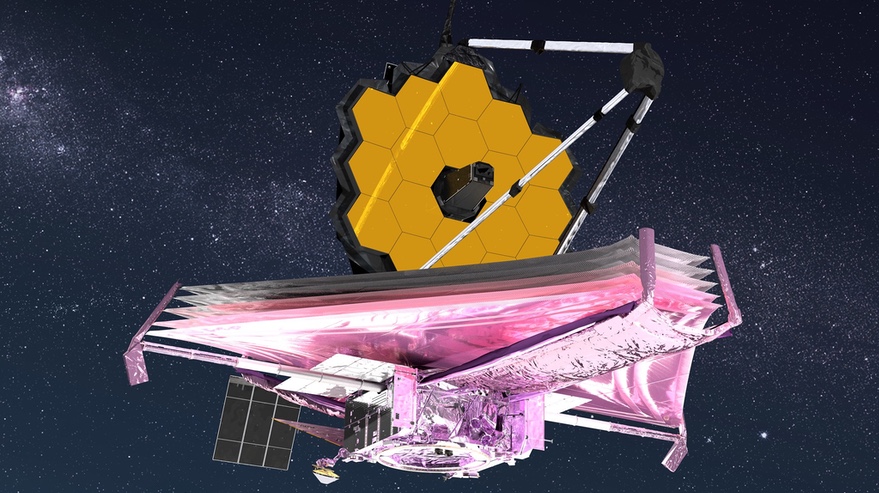WASHINGTON — While the impending launch of the James Webb Space Telescope has astronomers both excited and nervous, the liftoff marks only the beginning of the riskiest part of the mission.
NASA and other mission partners said Dec. 22 they remained on schedule for a Dec. 25 launch of JWST on an Ariane 5 from French Guiana after weather forced a one-day slip Dec. 21. The rocket is scheduled to roll out from its assembly building to the launch pad Dec. 23.
Liftoff is scheduled for between 7:20 and 7:52 a.m. Eastern on Dec. 25. If all goes as planned, JWST will separate from the rocket’s upper stage 27 minutes after liftoff.
While launch is typically the riskiest part of a spacecraft mission, it pales in comparison to what JWST will experience. Whereas the spacecraft is flying on a rocket that has been in service for more than two decades, with its last catastrophic launch failure in 2002, JWST will have to complete a series of first-of-its-kind complex deployments and maneuvers once it separates from the upper stage.
The first deployment takes place 33 minutes after liftoff, when it releases its solar panel. That will be followed by its first midcourse correction burn, called MCC-1a, which will take place 12.5 hours after liftoff.
Those two events are the most time-sensitive ones for the spacecraft, said Greg Robinson, JWST program director at NASA Headquarters, during a Dec. 21 call with reporters. “Everything else is flexible, but right now we’re certainly planning for a nominal timeline,” he said.
That nominal timeline calls for beginning deployment of its sunshield three days after launch. Two pallets on either side of the spacecraft will swing down with the sunshield folded within them. Two days later, covers protecting the sunshield material release, followed a day later by the deployment of two booms to extend the sunshield to its full dimensions. The five aluminum-coated Kapton layers of the sunshield are tensioned into place over the next two days, completing the sunshield deployment eight days after launch.
Deployment of the telescope mirror begins 10 days after liftoff when a tripod holding the small secondary mirror extends into place. Two wings, each holding three of the 18 segments of the primary mirror, then lock into place, completing deployment of the telescope 13 days after launch.
Months of work lie ahead after those deployments to align the telescope mirrors and commission the instruments as they cool to their operating temperatures, a process that won’t be completed until six months after launch. A maneuver 29 days after launch will place JWST into its final halo orbit around the Earth-sun L-2 Lagrange point, 1.5 million kilometers from Earth.
Those initial deployments, though, are among the most critical, and the riskiest. At a November briefing, Mike Menzel, JWST lead mission systems engineer at NASA’s Goddard Space Flight Center, said there are 344 single-point failures in the spacecraft, 80% of which are associated with deployment mechanisms. “When you have a release mechanism, it’s hard to put full redundancy into that,” he said.
The sunshield, for example, includes 140 release mechanisms, 70 hinge assemblies, eight deployment motors, about 400 pulleys and 90 cables that are a total of 400 meters long, said Krystal Puga, JWST spacecraft systems engineer at Northrop Grumman, during that November briefing.
“I think of the sunshield deployment similar to a Rube Goldberg machine, in that it uses a series of reactions that work in succession, triggering one event after the other until the entire sunshield is fully deployed,” she said, but added she was confident it would work properly.
“We performed multiple deployment testing over several years on both small and full-sized models,” she said. “This gives us the confidence that Webb is going to deploy successfully.”
“The things that we focused on for deployment is definitely the sunshield,” said Menzel. “The sunshield is one of these things that is almost inherently indeterministic.”
If something doesn’t go right during the deployment process, there are various contingency plans to try to fix the problem. Alphonso Stewart, JWST deployment systems lead at Goddard, said that the simplest fixes involve sending deployment commands again and checking telemetry for any erroneous signals.
More complex steps, he said, involve a “shimmy” where the spacecraft is rocked back and forth or a “twirl” to spin the spacecraft on one axis to free up a stuck element. Another step, dubbed “fire and ice,” would reorient the spacecraft to put sunlight on specific areas to heat up components. “That particular exercise, that contingency, is probably the last step,” he said. “We have quite a bit of alternative contingencies in the system.”
If a deployment problem can’t be fixed, it doesn’t necessarily mean the end of the mission. “I don’t think I would day that, if half of it didn’t deploy, we wouldn’t have a problem. We certainly would,” Menzel said of the sunshield. “If portions of it didn’t deploy exactly the way we wanted to, a lot of that would depend on where the misalignment was.”
The telescope has “cryogenic margins” that could absorb some problems with sunshield deployment. “We could have unknown heat loads, for instance, one that could come about because of the [sunshield] layers touching,” he said, especially if that contract was localized to one area of the sunshield.
Bill Ochs, JWST project manager at Goddard, said procedures are ready for any number of potential issues during deployment. “We don’t talk about what do we do if we fail. We talk about how we correct problems that we see on orbit and how we move forward from there,” he said.
While the sunshield and telescope deployments are among the riskiest phases of flight, he said he won’t relax after they’re done. “As the project manager, I won’t breathe a sigh of relief until we declare we’re operational 180 days after launch.”
